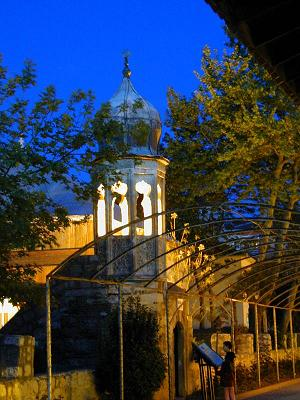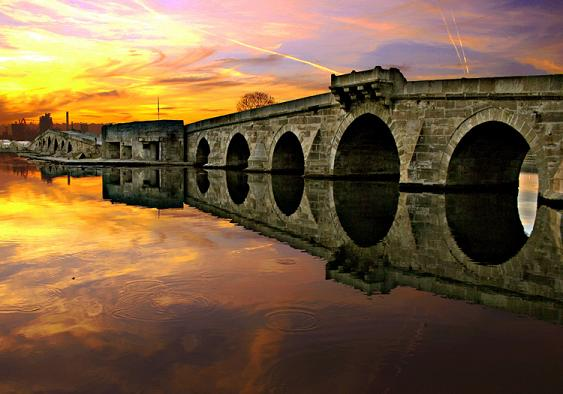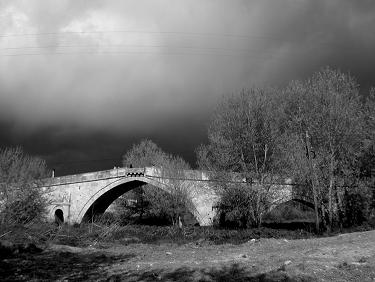
|
|




Excursion Route 1 - From Büyükçekmece to Havsa
Kapuağası (Haramidere) Bridge, Sokullu Mehmet Pasha Mosque, Sultan Süleyman Caravanserai, Sultan Süleyman (Büyükçekmece Bridge), Sultan Süleymen (Silivri) Bridge, Sokullu Mehmet Pasha Complex, Sokullu Mehmet Pasha (Lüleburgaz) Bridge, Sokullu Mehmet Pasha (Alpullu-Sinanlı) Bridge, Semiz (Cedit) Ali Pasha Mosque, Sokullu Mehmet Pasha (Kasım Pasha) Complex (Külliye)
Not all of Sinans masterpieces are located in close proximity to one another on this excursion route. It would be advisable to start your journey by private car in order to efficiently see everything on the list. Otherwise, you may lose time traveling from one location to another in search of Sinans works. Also, if you can follow both of the excursion routes along the Thracian Excursion Map within two consecutive days, as described below, you will able to appreciate the distinction of the magnificent public works undertaken by Sinan along the Sultanate Road from all the others.
We would like to suggest that you start this trip at Büyükçekmece, which was once a much preferred summer resort but is now a well-developed county of Istanbul. A sunny Saturday morning would be ideal for starting this trip. On your way to Büyükçekmece, make sure to see the Kapuağası (Haramidere) Bridge at Beylikdüzü. Unfortunately, a cloverleaf junction near this bridge prevents one from getting closer to the bridge. Nevertheless, a breakfast stop in this area, named the Culture Park by the Büyükçekmece Municipality, with full view of the Sultan Süleyman (Büyükçekmece) Bridge, the most grandiose of the three Sinan works here, may be a good start for a long and exhausting day.

Sokollu Mehmet Paşa Mosque and a domed mınarette
Following breakfast, the next stop will be the Sokullu Mehmet Pasha Mosque. This small mosque, which has not retained all of its original features due to repair work done at various times, is famous for its minaret known as the minbar minaret, that was designed as a separate structure from the mosque itself. If you happen to be there at prayer time, you will witness the muezzin personally chanting the call to prayer on the minbar minaret, a sight you may remember from days long gone and different from todays recorded broadcasts.

Sunset at the Sultan Süleyman Bridge
Süleyman Caravanserai. The Buuyükçekmece Municipality uses this building for special public events; it is closed to visitors on other days. It has reached our day in tact, in its original state, except for its roof covering.
Next is the Sultan Süleyman (Büyükçekmece) Bridge, the most resplendent of Sinans works. This is not only our judgment; in the text of Tezkiret-ul Bunyan, known to have been written by Sinans friend Sai Mustafa Çelebi, as recited by Sinan himself, this bridge is mentioned to be one of the structures he liked best among his works. Other proof of Sinans preference is the following verse inscribed on his tombstone in his mausoleum at Süleymaniye in the following script:
He hung such a lofty arch at Çekmece
Suspended in Heavens like the Milkyway
Sinan built this bridge in place of a previous one in the same area which was demolished due to faulty placement and replaced in a more appropriate location. Before starting its construction, Sinan explains the error in the location of the old bridge to Sultan Suleyman with these lines:
My Sultan, the reason that the old bridge was ruined is this: those who had built it took care in saving for the treasury and thus they built the bridge far from the sea, by the embankment. Therefore, the foundations were not resistant enough, so it has collapsed. In short, since the edge of the sea is shallow and more durable, I foresee that it will be better to build the bridge by the sea and thus I present to you the plan of the bridge I have made.
The bridge is composed of four sections. Sinan designed three landings at the connecting points of these four sections. The construction of the bridge is quite interesting in that it starts at these landings. First, basins were created using piles and these basins were then filled in to form the landings. What followed was the building of the arches of the four interlinked bridges. As you enter the bridge from the Büyükçekmece direction by the fourth section, you will see two inscription kiosks across from one another. On the kiosk to the north (on the right hand side), you will find Sinans signature plate, the only one on any of his works.
After viewing these three structures which despite being located close together are quite different from one another, follow the road towards Edirne until you reach Silivri (about 30 km). If you get on the TEM Highway it may take a little longer but you will be able to avoid the local traffic to reach the Damat Ferhat Pasha Mosque in Çatalca. The bridge built for Sultan Süleiman by Sinan in Silivri was closed to traffic in 2006. The viewing location of this bridge and its 32 equally sized and shaped arched openings is at the park, which also includes a statue of Sinan, commissioned by the Municipality of Silivri.
Approaching noontime, we recommend a snack or two at Silivri and heading for Tekirdağ in the direction of Çanakkale, for about another half hour, to taste Tekirdağs famous köfte (meatballs). The Rüstem Pasha Complex located in central Tekirdağ has only been partially for our modern day lives, with the mosque and a part of the madrasa in their original state. This stop will be further enriched by visiting the Tekirdağ Museum near the Rüstem Pasha Complex, the Namık Kemal Museum, and the Rakoczy Villa that was presented to the Hungarian Prince as a gift by Sultan Ahmet III.
After leaving Tekirdağ behind, head towards the direction of Edirne. The first stop will be the Sokullu Mehmet Pasha Complex that Sokullu had Sinan build as a stopping post. Near this Complex, the bridge, also built by Sinan, is quite attractive, yet it looks somewhat exhausted due to all the traffic on the road. The surviving structures from the Complex in the county center are the mosque, the madrasa, a boys school, arasta (shops), the double baths, and a small part of the caravanserai (only one wall and two small spaces). This handsome stopping post has received much abuse during the construction of the road and the Municipality Building. Unfortunately, small restaurants now use the double-baths section, which can be found in all Complexes of this type.
In about 500 meters from the Complex towards Edirne, you will cross over the bridge that was built for Sokullu Mehmet Pasha, popularly known as the Lüleburgaz Bridge. The inscription panel once placed on the inscription kiosk, midway on the bridge, is not there anymore. With their varying sizes, its water discharge basins are quite impressive. However, the pollution carried by the river and increased by the industrial zone right next to the river is has become a grave danger to the preservation of the structure.
Crossing over this bridge, which has been open to traffic to this day, in search of one other Sinan bridge, you should leave the main road and take a detour towards the Alpullu Sugar Factory. After passing by the factory and upon reaching the Alpullu Train Station, you come very close to the location of this very special bridge. Perhaps the most handsome of the Thracian bridges, its magnificence will be well worth the long journey. Its 20 meter arch is the largest span among all of Sinans bridges. You will find viewing the sheep herds in search of sugar beat stems during harvest time quite impressive.
Returning to the main road as the day draws to a close, you now have only two more Sinan buildings left to see: Semiz (Cedit) Ali Pasha Mosque (right by the entrance to Babaeski) and Sokullu Mehmet Pasha (Kasım Pasha) complex in Havsa. From this complex, built according to the bequest of Semiz Ali Pasha, only the mosque remains. Luckily, the complex in Havsa was more fortunate and faired better. Sokullu Mehmet Pasha had this complex built by Sinan, for his son Kasım Pasha. The mosque is in tact but its narthex is not there any more; the heated sections of the double bath are partially preserved and the grand dome of the prayer section in the market also exist to this day.

A black and white view of the Sokollu Mehmet Paşa Bridge at Lüleburgaz
The sun will be setting as you drive from Havsa to Edirne, about 20 minutes away. As you approach the city, the grand silhouette of the Selimiye Mosque is a welcoming view. Our recommendation is to spend the night in Edirne, one of the three Capitol cities of the Ottoman Empire, and continue with your tour of this Sinan Excursion Route the following day. A good place for dinner is Köfteci Osman where you will be able to enjoy your dinner with the Selimiye Mosque in full view.
| © 2006 Respect to Sinan. All rights reserved. | [Çekül Foundation] [Union of Historical Towns] |
